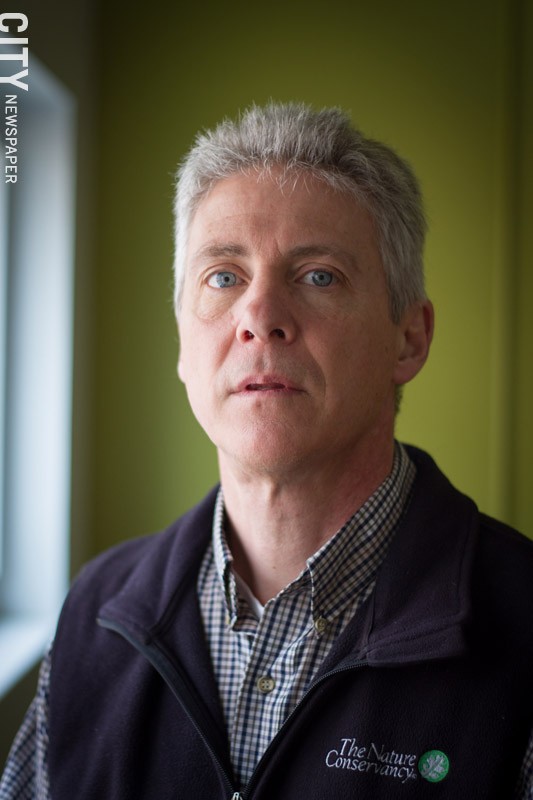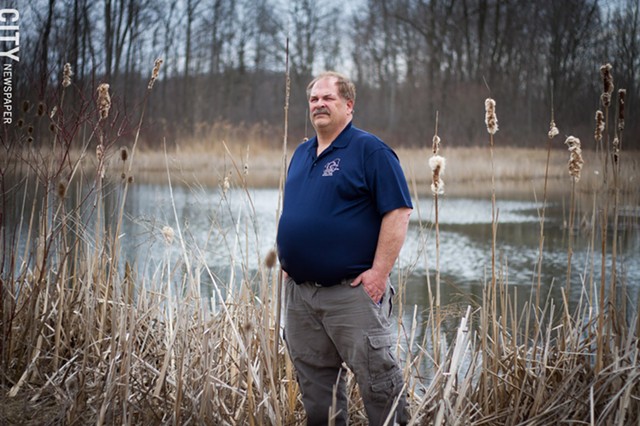We are a country and a world at odds with itself. This has always been the case to some degree, but productive debate seems practically impossible right now.
Every question becomes a fight; every disagreement becomes a war. Pick an issue, and people on either side of it feel that they're under attack.
This is the backdrop for Earth Day 2017. Traditionally, Americans come together on April 22 to recognize the incalculable value of the environment. But this year, will there be much to commemorate? If people can't even talk to each other, how can they agree on ways to make this planet a better place?
The situation isn't as hopeless as it sounds, though: there's still some pretty solid ground underneath major environmental issues, even though it may not feel like it.
Climate change is about as divisive as an issue can be, and the White House won't be making any positive changes. President Donald Trump thinks climate change is bunk, and his 2018 budget proposal yanks funding from every major federal climate program. Leaders of the Senate and House Republican majorities also dismiss the issue entirely, along with efforts at addressing it.
But climate action is not a lost cause. There was even something of a bright spot, recently, in the politics around climate change: Republican Representative Elise Stefanik of New York's North Country led a House resolution urging GOP leaders to take on climate change, a measure supported by fellow Empire State Republicans Tom Reed and John Katko.
The three Republicans asked GOP leaders to "commit to working on economically viable solutions that address the threat of climate change," according to a press release from Stefanik's office. They're hardly calling for a sudden shift off of fossil fuels, but they've got their feet on the same figurative ground that climate activists do.
These representatives provide a starting point, although activists must continue to press government leaders and agencies for action on climate change. In addition, citizens need to make sure their lawmakers at all levels know they expect meaningful policies to reduce carbon emissions. And states such as New York must continue their own efforts to cut emissions.
Trump's 2018 budget proposal gouges away at other crucial areas: clean water and clean air programs, weather forecasting services, public lands and national parks, and fundamental scientific programs. But some of these issues, at least in the past, have united people from varying ideological, political, and demographic backgrounds.
Old threats are new again, and in the spirit of Earth Day, it's worth taking some time to talk about the common ground people have found, or are finding, on the environment.
But first, a caveat: Fundamentally, this is an exploration of the way humans deal with problems. It's a discussion about people whose philosophies, ideas, and approaches don't always mesh precisely, and who sometimes form unlikely alliances.
Often, what people are willing to take on comes down to perspective and personal impact. The search for common ground is imperfect if not messy, and sometimes broader problems are overlooked.
And in each of these areas, everyone could do better: liberal or conservative, corporation or government, hunter or hiker, tree-hugger or forester.
Clean drinking water
Everyone wants access to safe, unpolluted drinking water, and right now this is the issue in New York and the rest of the US. This is the richest country in the world, and entire communities lack sources of clean drinking water.
What happened in Flint, Michigan, really grabbed the public's attention. The officials in charge of the struggling Rust Belt city made a cost-driven decision to switch water supplies and, long story short, water from the new source was corrosive and the city didn't properly treat it. As a result, lead leached from the aged public water lines into thousands of households.
Flint's water problems have persisted for years and they still aren't fixed, despite national outrage. The Trump EPA, which has attacked so many environmental programs, recently granted Michigan $100 million to replace its lead service lines.
The crisis also serves as a reminder that poor people and communities of color are often disproportionately affected by environmental problems and public health problems. More than half of Flint's residents are black, and just under half of the city's population lives below the poverty line.
Back in New York, the small Village of Hoosick Falls, not far from Albany, gave New Yorkers are sharp reminder of just how vulnerable our water sources are. Village residents were notified in late 2015 that they shouldn't drink water from the municipal system – or from private wells – because the groundwater source was contaminated with PFOA from a nearby plastics plant. PFOA is used in the process of making Teflon and chemicals like it, and research has determined that it's a potential carcinogen, according to the American Cancer Society.
But state, federal, and local officials apparently knew about the contamination for years, a revelation that prompted outrage across the state.
Groundwater contamination has since been detected in other New York communities. The state now has a rapid-response team that's intended to assess potential water quality problems, issue warnings, and initiate remedies more quickly than in the past.
Governor Andrew Cuomo's 2017-18 state budget proposal includes a five-year, $2 billion Clean Water Infrastructure Act. The money would be used to extend and improve wastewater treatment systems; protect open spaces and build wetlands that filter storm water; and provide more state Superfund money to clean up sites that may contaminate water supplies.
Across the state, Republican and Democratic leaders, environmental groups, conservation groups, labor unions, and business groups have rallied to support the governor's budget measure and increased state funding for water infrastructure in general.
Republicans in the State Senate have proposed a larger, $5 billion borrowing measure to fund water infrastructure projects.

- PHOTO BY KEVIN FULLER
- Clean water is a uniting issue, says Jim Howe, executive director of the Nature Conservancyof Central and Western New York.
"I think that is a uniting issue," says Jim Howe, executive director of the Nature Conservancy of Central and Western New York.
But it's an issue that also has its limits. The Standing Rock Sioux tribe has fought construction of the Dakota Access pipeline because of its potential to pollute its refuge's water supply. The Trump administration waved the project ahead, even though the tribe's resistance gained national attention and support. Some big banks, however, have started divesting from the project.
Habitat conservation and open space protection
Braddock Bay is a lot of things to a lot of people. Hunters pursue fowl in its marshes; anglers of all skill levels cast their lines in its waters; kayakers and canoers paddle through its wetland channels; birdwatchers train their binoculars on the different species flitting around the cattails; and biologists study its abundant wildlife.
A few years ago, the US Army Corps of Engineers developed a plan to protect and restore the bay's shorefront wetlands, but it needed federal funding to finish the designs and carry out the project.
Democratic Senator Chuck Schumer pushed for the funding with backing from Republican Greece Supervisor Bill Reilich and bay-area residents. The EPA approved $9 million for the project, which involves reconstructing a barrier beach at the bay's inlet, and it should be finished this year.
The project is not an exception. People otherwise separated by political or social boundaries frequently come together to preserve ecologically sensitive lands such as the Braddock Bay wetlands and to protect open space.
However, the federal program that paid for the work is now in jeopardy. In his 2018 budget proposal, President Trump slashes the Great Lakes Restoration Initiative from $300 million – the minimum it has received each year since its 2010 start – to zero. Republican governors from Great Lakes states, as well as Republicans in the House and Senate from those states, made swift calls for the funding to be restored.
The GLRI has funded a long list of water quality, toxic site clean-up, habitat improvement, and invasive species management and prevention programs throughout the Great Lakes region.
The US has a long tradition of protecting valuable animal habitat through the use of public lands. Take the federal duck stamp program as an example. The program started during the Great Depression at the urging of conservationist duck hunters who were worried about declining waterfowl habitat.
All waterfowl hunters have to buy one of the $25 stamps, but many birdwatchers, environmentalists, naturalists, and outdoors enthusiasts buy them, too. Duck stamp money has been used to establish or expand 300 refuges spanning all 50 states, including the Iroquois National Wildlife Refuge to the west of Rochester and the Montezuma National Wildlife Refuge to the east.

- PHOTO BY KEVIN FULLER
- Joe Nicosia, a past statewide chair of Ducks Unlimited, says people often embrace conservation because they want to leave the world better than they found it.
"I think everybody deep down wants to leave a legacy and leave this earth a little bit better than it was when we came here," says Joe Nicosia of Newark, Wayne County, and a past New York State chair of Ducks Unlimited. "I think that's one of the main points that ties a lot of people into conservation, to be honest with you."
And open space, in general, can be a very local concern. Penfield residents banded together in early 2016 after the owner of the Shadow Lake and Shadow Pines golf courses put the properties up for sale. Community members – Democrats, Republicans, and independents – didn't want to see the courses developed into a housing tract, which was a distinct possibility. They began pressuring town officials to buy or otherwise protect the properties.
The all-Republican Town Board put a development moratorium in place, which the members recently extended, so it could explore some options. Town officials have taken steps toward a ballot measure on buying the property, which the owner has previously said it would sell to the town.
"When somebody's connected to a community or the place that they live, they'll go to any length to protect it," says Kate McArdle, a Penfield resident, member of the Save Shadow Pines citizens group, and the town's Democratic leader.
Renewable energy
The leading wind-energy producing state isn't liberal California or crunchy Vermont, it's deep red Texas. This is partly because of the state's plethora of wide-open space and its exceptional wind resource, but political will plays a role, too. Companies put up hundreds of turbines in the Lone Star State because the public and policy-makers, including former governor and current US Energy Department head Rick Perry, were on board.
Republican lawmakers in New York have been similarly accepting of – if not enthusiastic about – on-site solar power for homes and businesses. They've supported regulatory changes meant to encourage the technology's growth, and they've backed incentives for homeowners and businesses that install the systems. And GOP municipal leaders across Upstate have pursued solar projects as a way to cut their governments' costs.
These officials rarely talk about renewables in terms of climate change, even though the technologies are a crucial tool for reducing carbon emissions. Instead, they use a frame of economics, sustainability, and efficiency. For example, solar saves homeowners and businesses money, it helps cut down on the energy that big power plants have to produce, and it creates jobs, because people have to make, sell, and install the equipment.
Wind power still remains a divisive issue in New York. Some communities have accepted, even welcomed large wind farms. But others have fought or are fighting turbine proposals. In the Orleans County towns of Yates and Somerset, local, state, and federal elected officials have mounted a multi-pronged offensive against the proposed Lighthouse Wind project, for example.
Waste reduction and recycling
Garbage is a really complex issue that involves everything from high-level decisions at the world's largest corporations to individual habits. The bare truth is that American society generates literal mounds of garbage every day.
The public has a general sense that, collectively and as individuals, is should make some attempt to cut down on the amount of stuff that gets trucked into landfills. Households are composting kitchen scraps and yard waste, and retailers including Wegmans are using several different approaches to prevent food waste and to divert scraps from landfills. Some big retailers have also used their buying power to get suppliers to pare down product packaging.
Municipal recycling programs have also grown. A few years ago, Monroe County began accepting a broader variety of plastics through its recycling center. And more recently, it switched to single-stream recycling; officials hoped the move would increase household recycling because residents would no longer have to sort their bins by material.
But waste reduction, like renewable energy, has environmental and economic benefits. Sending garbage to landfills costs money, and once the waste is buried, it sits and slowly decomposes, if it breaks down at all.
Companies save money by reducing packaging, and governments make money by selling recyclables. When food scraps are composted, they become a rich, environmentally beneficial fertilizer. In other words, they turn a potential cost into something valuable and useful.
These are benefits that bottom-line business types and environmentally aware consumers both seem to appreciate. And that's good, because waste is something society needs to work harder on.
People generate more waste now, on a per capita basis, than they did in the 1960's, according to Environmental Protection Agency figures.
Next steps
Looking ahead, there may be other opportunities to find common ground. Climate adaptation will be increasingly important to farmers, forest managers, gardeners, utilities, and communities on coasts and rivers. But in order to make the actions palatable, the discussions may be couched around growing seasons, crop management, flood mitigation, and power-grid resiliency. (Power companies don't want blackouts when their customers all flick on their air conditioners).
People can look within their own communities, too. Making neighborhoods more walkable and bikeable can help cut down on the amount people have to drive, and it can make towns, villages, and cities healthier, more pleasant places to live. And the efforts tend to be relatively popular, both politically and at the community level.
But finding common ground will require persistence and flexibility. Advocates and activists have achieved some big victories by starting at the very bottom and talking with neighbors, family, friends, and elected leaders at all levels. Do that, and if someone isn't totally in line with your thinking, find where you agree and go from there.
Everyone has to live on the same Earth, after all.


